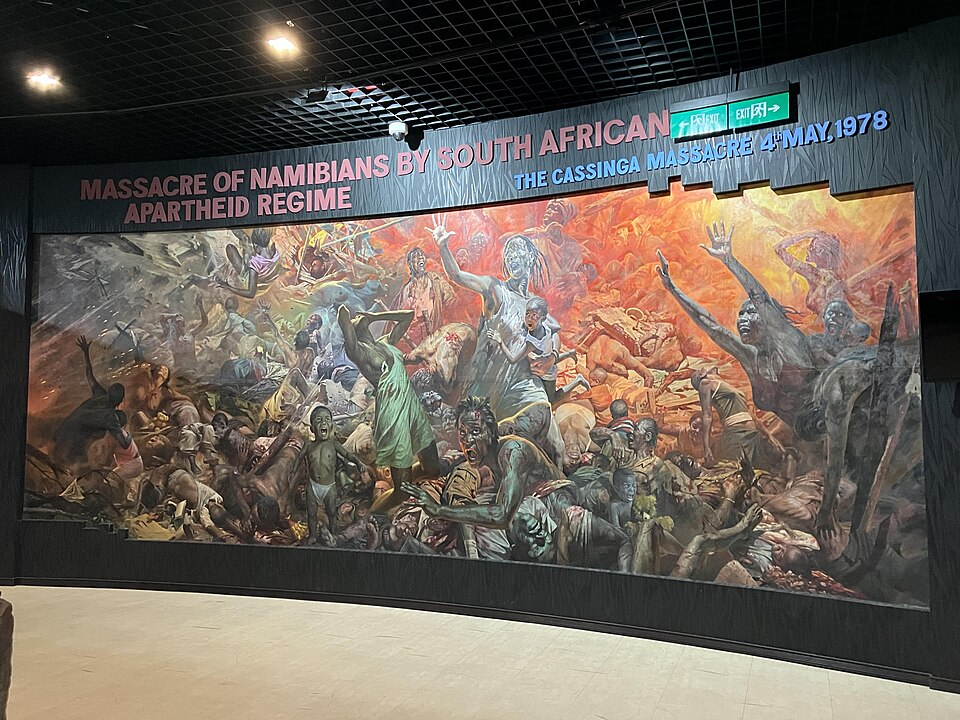IB Syllabus focus:
'Analyze the efforts of SWAPO in the quest for Namibia's independence, culminating in the country's freedom in 1990.'
The journey of Namibia’s independence is a poignant chapter in African history, marked by decades of struggle, international diplomacy, and the unwavering spirit of its people, under the banner of the South West Africa People’s Organisation (SWAPO).
Origins and Formation of SWAPO
Background and Emergence
Pre-1960s, Namibia, known as South West Africa, was under South African administration, mandated by the League of Nations, a rule marked by apartheid policies.
Post World War II, rising tides of nationalism and decolonisation in Africa influenced Namibian resistance against South African rule.
Formation and Founders
SWAPO emerged in April 1960, succeeding the Ovamboland People's Congress.
Founded by Herman Toivo ja Toivo and Sam Nujoma among others, who became prominent figures in Namibia’s independence narrative.
Political Mobilisation and Ideology
Strategies for Mobilisation
Initiated grassroots campaigns, using ethnic solidarity, particularly among the Ovambo majority.
Organised labour movements and protests to highlight the oppressive South African regime.
Strategically campaigned for the recognition of Namibian self-rule at the United Nations and through international diplomacy.
Ideological Framework
Influenced by Marxism-Leninism and pan-Africanism, advocating for a classless society and united Africa.
Ideals of self-determination, human rights, and independence from colonial rule formed the core of SWAPO’s philosophy.
International Recognition and Support
The Role of the United Nations
The General Assembly terminated South Africa's mandate in 1966, although South Africa did not recognise this termination.
SWAPO gained observer status at the UN and by 1973 was recognised as the 'sole legitimate representative' of the Namibian people.
Global Allies
Received military training and funds from the Soviet Union and other Eastern Bloc countries.
Scandinavian nations provided humanitarian aid and advocacy support.
African solidarity was strong, with support from the Organisation of African Unity (OAU) and frontline states like Angola and Zambia.
Armed Struggle: The People's Liberation Army of Namibia (PLAN)
Commencement of Armed Resistance
The armed wing, PLAN, initiated an insurgency against South African control in 1966.
Employed guerrilla tactics, attacking South African military installations and mobilising rural populations.
Key Military Engagements
The Omugulugwombashe raid is significant as it represented the first armed engagement and symbolised the commencement of the liberation struggle.
The Cassinga Massacre in 1978, where a South African airborne assault led to heavy civilian casualties, drew international condemnation and increased support for SWAPO.

Depiction of the 4 May 1978 Cassinga attack, memorialised in Windhoek’s Independence Museum. As a curated museum panel, it includes commemorative and interpretive elements in addition to the core historical facts required by the syllabus. Source
Internal Dynamics and Challenges
Ethnic Diversity and Unity
Despite its predominant Ovambo support base, SWAPO worked towards inclusivity across ethnic lines, incorporating minority groups into its structure and programmes.
Efforts were made to transcend ethnic divisions, promoting a unified Namibian identity.
Human Rights Accusations
Reports of human rights abuses in SWAPO camps, including detentions and executions of suspected spies, led to criticism and internal conflict.
These reports somewhat tainted SWAPO’s international image and necessitated a concerted effort towards transparency and reform.
Diplomatic Struggle and United Nations Transition Assistance Group (UNTAG)
Negotiation and UN Involvement
Diplomatic negotiations were protracted and complex, involving bilateral and multilateral talks.
The 1988 Tripartite Accord, signed by Angola, Cuba, and South Africa, facilitated the withdrawal of foreign troops from Angola and the independence of Namibia.
UNTAG’s Mandate
UNTAG's mandate extended to ensuring peace, overseeing the transition government, and preparing for free elections.
Played a pivotal role in demobilisation, human rights monitoring, and maintaining law and order during the transition period.
The Road to Independence
Electoral Victory and International Monitoring
UN-supervised elections in 1989 led to a resounding victory for SWAPO, though it fell short of the two-thirds majority needed to have a free hand in drafting the constitution.

UNTAG staff oversee ballot validation at Windhoek Showgrounds during the 1989 elections, a core part of the UN’s mandate to ensure a peaceful, credible transition. The operation involved more than 6,000 civilian and military personnel across Namibia. Source
International observers hailed the elections as free and fair, laying the groundwork for international recognition of Namibia's independence.
Establishment of Sovereignty
Independence was formally granted on 21 March 1990, with the South African flag lowered and the new Namibian flag raised.
A new constitution, championing human rights and a multiparty democratic system, came into effect, marking a new era for the nation.
Post-Independence Challenges and SWAPO’s Evolution
Nation-Building and Governance
Transitioning from a liberation movement to a ruling party, SWAPO faced the immense task of nation-building.
Policies aimed at national reconciliation, economic development, education, and infrastructure were prioritised.
Continued Political Dominance
SWAPO has maintained its position as the dominant political force in Namibia, leading the country through several election cycles.
Governance under SWAPO has been scrutinised for its handling of pressing issues such as land redistribution, economic disparity, and allegations of nepotism and corruption.
Namibia’s struggle for independence, with SWAPO as the vanguard, showcases an intersection of guerrilla warfare, political diplomacy, and the resilience of a people striving for self-determination. SWAPO’s journey from a liberation movement to the ruling party underscores the challenges inherent in transitioning from colonial rule to self-governance and the continuing quest for national development and unity. This legacy continues to influence Namibia’s sociopolitical landscape, with SWAPO’s actions shaping the narrative of the nation’s history and its future trajectory.
FAQ
Transitioning from a liberation movement to a ruling party posed several challenges for SWAPO. After independence, SWAPO had to shift from its militaristic approach to governance and diplomacy to stabilising the nation and building its institutions. This included drafting a new constitution, promoting national reconciliation, and transitioning to a peacetime economy. Additionally, SWAPO had to contend with high expectations from its citizens, who anticipated rapid social and economic improvements. Integrating former fighters, addressing land reform, and maintaining unity in the face of diverse political opinions also emerged as significant issues. Balancing the idealism of their revolutionary struggle with the pragmatism required in government was one of the most profound adjustments for SWAPO.
SWAPO's relationship with other African independence movements provided both inspiration and tangible support for their cause. Solidarity with movements in countries like Angola and Zimbabwe influenced SWAPO's tactics and bolstered their morale. Support from the Organisation of African Unity (OAU) and from independent African countries provided critical diplomatic backing. These relationships facilitated SWAPO's use of bases in neighbouring countries for training and planning. Moreover, the success of other movements in achieving independence provided a model and hope that Namibia could follow the same path. The exchange of ideas and strategies among these movements also helped to refine SWAPO's approach to both armed struggle and international diplomacy.
United Nations Security Council Resolution 435, adopted in 1978, was instrumental in setting the framework for Namibia's transition to independence. It called for free and fair elections under UN supervision and the withdrawal of South African troops. The resolution laid out a comprehensive plan for the establishment of a ceasefire, the return of refugees, and the implementation of a UN peacekeeping force (UNTAG) to oversee the transition process. Although its implementation was delayed until 1989 due to South African resistance and regional conflicts, the resolution was a turning point as it provided a legitimate and internationally recognised pathway to independence. It signalled the end of South Africa's illegal occupation and the beginning of Namibia's sovereignty.
The Cold War had a significant impact on SWAPO's international support and strategies. Operating within this global tension, SWAPO managed to leverage support from the Soviet Union and its allies, receiving military training and financial aid crucial for sustaining their armed struggle. This support was part of the larger context of Soviet backing for anti-colonial movements in Africa, serving as a counterpoint to Western powers' interests. Additionally, SWAPO's alignment with socialist and Marxist ideologies resonated with the Eastern Bloc's geopolitical aims. However, they also maintained a non-aligned stance that enabled them to garner support from Western countries and international bodies like the United Nations, who were interested in advancing decolonisation without directly challenging South African sovereignty.
SWAPO, while predominantly supported by the Ovambo ethnic group, faced internal challenges related to ethnic diversity. The movement strived to present a united front despite Namibia's ethnic heterogeneity. However, internal tensions sometimes surfaced, potentially threatening the cohesion of the independence movement. To mitigate this, SWAPO promoted inclusivity and a collective Namibian identity, which was crucial in maintaining the unity necessary for a successful independence struggle. The internal political dynamics, particularly the leadership's ability to manage ethnic diversity and dissent, were essential in maintaining the focus on the broader goal of independence and presenting a unified stance to the international community and South African administration.
Practice Questions
SWAPO's diplomatic strategies were highly effective in garnering international support, which was crucial for Namibia's independence. By obtaining observer status at the UN and later recognition as the legitimate representative of Namibia, SWAPO secured a platform to voice the Namibian struggle. The organisation skillfully navigated Cold War dynamics, gaining support from both the Eastern Bloc and non-aligned states, thus ensuring diverse backing. Their ability to link Namibia's struggle with global decolonisation movements further strengthened their international appeal. The culmination of these efforts was evident in the UN-supervised elections, a clear diplomatic victory for SWAPO, leading to Namibia's independence in 1990.
The armed struggle led by SWAPO significantly impacted Namibia's path to independence. It was a demonstration of the Namibian people's resolve to achieve self-determination. Actions like the Omugulugwombashe raid were pivotal in escalating the conflict, leading to increased international scrutiny and pressure on South Africa. Although the armed struggle was marked by hardship and loss, notably in events like the Cassinga Massacre, it drew global condemnation of South Africa and highlighted the Namibian cause. The struggle also forced South Africa to negotiate, culminating in the Tripartite Accord and the implementation of UNTAG, thereby paving the way for independence.

